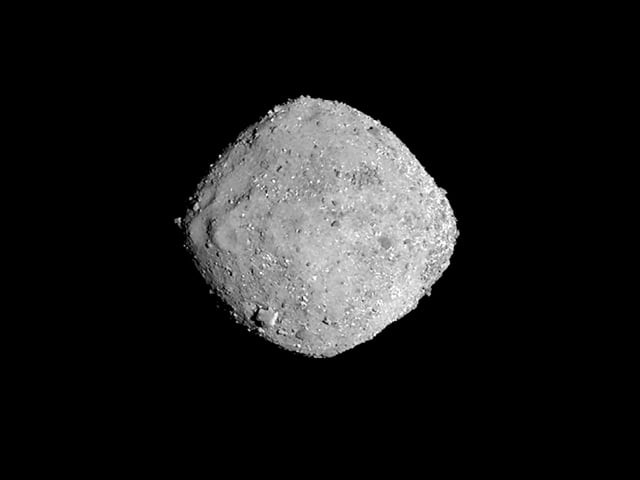NASA's first asteroid sample-collector arrives at target, Bennu
Bennu asteroid, about the size of small mountain, is smallest object ever to be orbited by a human-made spacecraft

This November 16, 2018 photo from NASA s OSIRIS-REx spacecraft, obtained December 3, 2018 courtesy of NASA/Goddard/University of Arizona, shows the asteroid Bennu from a distance of 85 miles (136 km). PHOTO: AFP
The $800 million unmanned mission, known as OSIRIS-REx, made a rendez-vous with the asteroid at around 12:10 pm (1710 GMT), firing its engines a final time.
"We have arrived," said Javier Cerna, an engineer at Lockheed Martin, as his colleagues at mission control in Littleton, Colorado cheered and exchanged high-fives, according to a live NASA television broadcast.
Bennu is about 1,600 feet (500 meters) in diameter, about the size of a small mountain. It is the smallest object ever to be orbited by a human-made spacecraft.
A fragment of the early solar system, Bennu is also considered potentially dangerous. It poses a slight risk -- a one in 2,700 chance -- of colliding with Earth in 2135.
Anxiety at NASA as Mars InSight spacecraft nears Red Planet
The carbon-rich asteroid was chosen from some 500,000 asteroids in the solar system because it orbits close to Earth's path around the Sun, is the right size for scientific study, and is one of the oldest asteroids known to NASA.
Scientists hope it will reveal more about the early formation of the solar system, as well as how to find precious resources like metals and water in asteroids.
"With asteroids, you have a time capsule. You have a pristine sample of what the solar system was like billions of years ago," said Michelle Thaller, a spokeswoman for NASA's Goddard Space Flight Center.
"That is why for scientists this sample is going to be far more precious than even gold."
The mission launched in September 2016. Over the past several months, OSIRIS REx has been creeping toward Bennu, and finally reached the space rock when it was about 80 million miles (129 million kilometers) from Earth.
"For the past several months, Bennu has been coming into focus as I approached," said NASA's OSIRIS-REx Twitter account.
"Now that I'm here, I'll fly around the asteroid and study it in detail."
The spacecraft is equipped with a suite of five science instruments to study the asteroid for the next year and a half, mapping it in high resolution to help scientists decide precisely where to sample from.
NASA poised to launch first Sun-skimming spaceship
Then, in 2020, it will reach out with its robotic arm and touch the asteroid in a maneuver Rich Kuhns, OSIRIS-REx program manager with Lockheed Martin Space Systems in Denver, described as a "gentle high-five."
Using a circular device much like a car's air filter, and a reverse vacuum to stir up and collect dust, the device aims to grab about two ounces (60 grams) of material from the asteroid's surface, and return it to Earth for further study.
NASA says it may get much more material, perhaps up to four pounds (two kilograms).
The US space agency hopes to use OSIRIS-REx to bring back the largest payload of space samples since the Apollo era of the 1960s and 1970s, when American explorers collected and carried back to Earth 842 pounds (382 kilograms) of Moon rocks.
Japanese space agency JAXA first proved sample collection from an asteroid was possible.
JAXA's Hayabusa spacecraft crash-landed into the surface of its target asteroid and managed to return a few micrograms of material in 2010.
Once the NASA mission has successfully collected its spacedust from Bennu, the sample will be kept in a canister and returned to Earth in 2023, touching down in the Utah desert in late September, NASA said.



















COMMENTS
Comments are moderated and generally will be posted if they are on-topic and not abusive.
For more information, please see our Comments FAQ